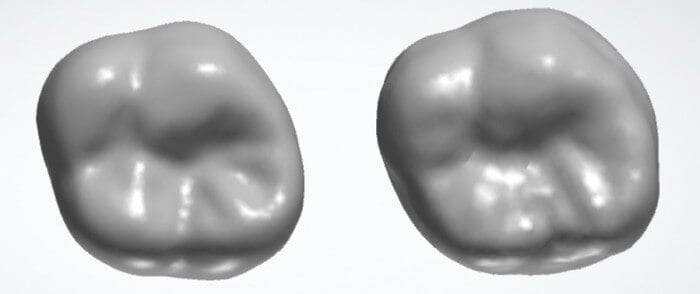Leading researchers from the Faculty of Dentistry at the University of Hong Kong (HKU) have developed a novel smart manufacturing on dental crowns by using generative artificial intelligence (AI) that leverage dental manufacturing technology.
The team, led by Dr James Tsoi, Associate Professor in Dental Materials Science collaborated with colleagues from HKU Faculty of Engineering’s Department of Computer Science to take a leap forward for the next-generation AI-designed dental prosthesis production workflow.
The researchers developed a generative AI algorithm that uses a true three-dimensional (3D) deep learning approach, producing personalised dental crowns with high accuracy that mimic the morphology and match the materials required for the biomechanics of natural teeth. Biomechanical finite element analysis revealed that by using lithium silicate, the AI-designed crown can come very close to achieving the expected lifespan of natural teeth. In contrast, the two existing methods of designing dental crowns result in crowns that are either too large or too thin, and fall short of matching the same lifespan as natural teeth.
The results have been published in leading academic journal Dental Materials in an article titled ‘Morphology and mechanical performance of dental crown designed by 3D-DCGAN’.
Currently, the Computer-Aided Design and Manufacturing (CAD/CAM) digital workflow has significantly improved dentistry but still has its challenges. From the design to the manufacture of dental prostheses, the process is labour-intensive, time-consuming, and generates health and environmental hazards during the 3D printing and milling processes. The software uses a ‘tooth library’ that contains predefined crown templates to assist in generating prosthetic designs but further adjustments are still needed by the operator to meet individual conditions.
The smart manufacturing method developed by the research team can meet the challenge and help replace the conventional approach to designing personalised dental crowns.
“We used a 3D-DCGAN (3D-Deep Convolutional Generative Adversarial Network) approach to ‘teach’ the AI algorithm ‘good’ designs by feeding the algorithm with over 600 cases of natural and healthy dentition. The algorithm improves the quality of the design through internal competition between a generator and a discriminator,” said Dr Hao Ding, a co-investigator on the project.
“During the training process, natural teeth morphological features were learned by the algorithm, so that it can design dental crowns comparable to a natural tooth — both morphologically and functionally.” Dr Ding added.
The 3D-DCGAN AI-designed crowns were compared with natural teeth and with two other conventional CAD methods of crown design methods. The results revealed that the generative AI-designed crowns had the lowest 3D discrepancy, closest cusp angle (morphological feature), and similar occlusal contacts (functional feature) as compared to natural teeth.
“This demonstrates that 3D-DCGAN could be utilised to design personalised dental crowns with high accuracy that can not only mimic both the morphology and biomechanics of natural teeth, but also operate without any additional human fine-tuning, thus saving additional costs in the production process,” said principal investigator Dr James Tsoi.
“Many AI approaches design a ‘look alike’ product, but I believe this is the first project that functionalise data-driven AI into real dental application. We hope this smart manufacturing technology will be the stepping-stone for driving Industry 4.0 in dentistry, which is vital to meet the challenges of ageing society and lack of dental personnel in Hong Kong.” He added.
Dr Tsoi said the breakthrough marks an important step towards leveraging the dental industry in Great Bay Area, which sees an annual USD3.3B revenue for producing 25-30% dental prosthesis globally, and to align with the National 14th Five-year plan in developing new forms of industrialisation and informatisation viz. smart intelligent manufacturing.
Clinical trials for using this generative AI for dental crowns are underway. The team is also working on the applicability of this tool in other dental prostheses such as bridges and dentures.
The study was supported by the General Research Fund (GRF), the Innovation and Technology Fund Mainland-Hong Kong Joint Funding Scheme (ITF-MHKJFS), and the Health and Medical Research Fund (HMRF). Its preliminary results were presented by Dr Hao Ding at the 35th Annual Scientific Meeting of the International Association of Dental Research (IADR) Southeast Asia (SEA) and it was awarded the leading IADR-SEA Research Category Award (Dental Materials and Biomaterials Category) in 2021.
The article in Dental Materials titled ‘Morphology and mechanical performance of dental crown designed by 3D-DCGAN’ published in Dental Materials, can be accessed through this link.

